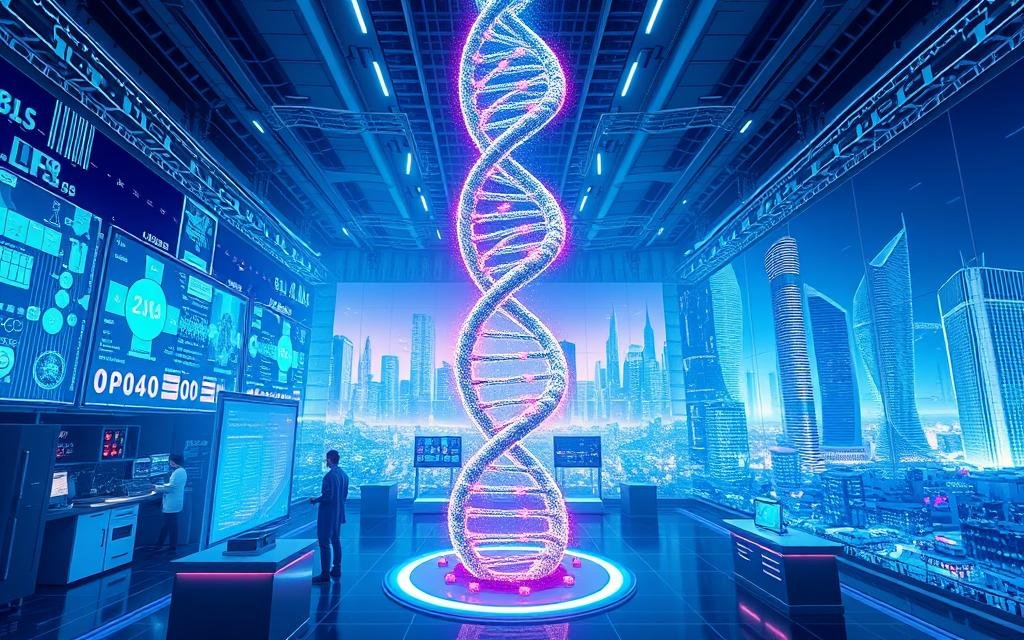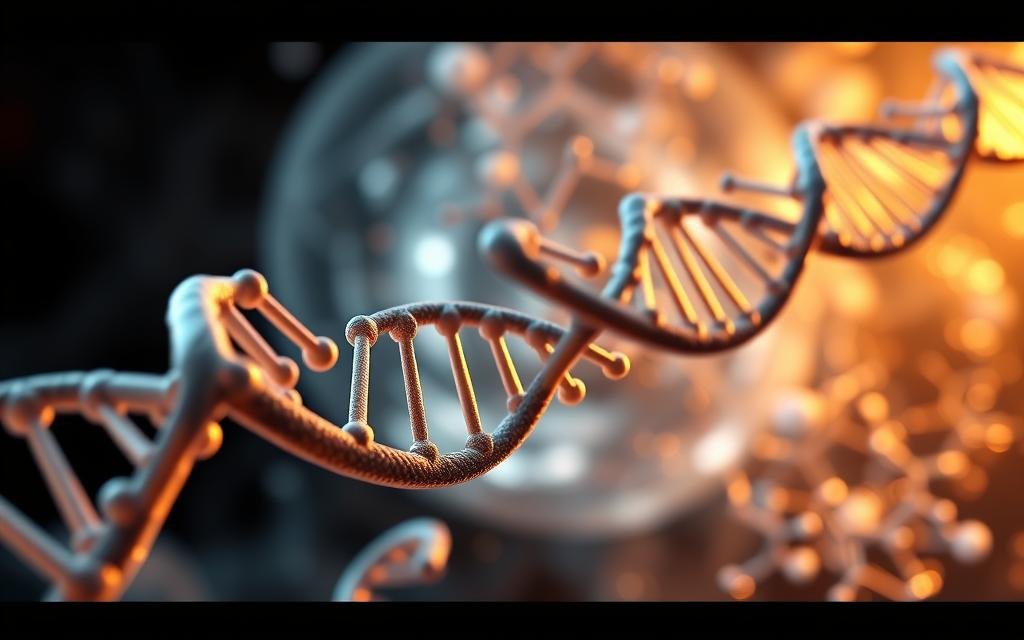Every day, the world generates 2.5 million gigabytes of new information. That’s enough to fill countless hard drives—but what if you could store it all in a coffee mug? According to MIT’s Mark Bathe, DNA data storage makes this possible.
Unlike traditional methods, this breakthrough offers 1,000 times the density of flash memory. Once synthesized, it requires zero energy to preserve for decades. Imagine replacing football-field-sized data centers with a tiny vial.
With rising costs—over $1 billion annually for data centers—archival solutions must evolve. Could this be the answer? Let’s explore how it works and why it matters.
Key Takeaways
- Global data grows by 2.5 million gigabytes daily.
- DNA-based systems fit vast archives in minimal space.
- Zero energy is needed for long-term preservation.
- Current data centers cost billions to maintain.
- Future tech may rely on biological solutions.
What Is DNA Data Storage?
Imagine preserving an entire library in a drop of liquid. This isn’t science fiction—it’s the promise of a revolutionary storage medium. Instead of zeros and ones, information is encoded into biological sequences (A, T, G, C).
Understanding the Basics
Digital files are converted into nucleotide pairs. For example, 00 becomes G, and 01 becomes C. Microsoft’s 2018 demo stored 200MB—including a HD video—using this method. Redundant encoding fixed errors, ensuring accuracy.
How DNA Encodes Digital Data
Traditional chemical synthesis is expensive. The Wyss Institute’s enzymatic approach cuts costs by using natural enzymes. George Church proved this in 2012 by encoding his book into biological form.
| Method | Cost | Speed | Accuracy |
|---|---|---|---|
| Chemical Synthesis | High | Slow | 99.9% |
| Enzymatic Synthesis | Low | Fast | 99.5% |
This table shows why enzymatic techniques are gaining traction. They balance affordability with precision, making large-scale use feasible.
Why DNA Data Storage Could Revolutionize Archiving
What if you could store the entire digital world in a sugar cube? Traditional methods like magnetic tape require warehouses—yet biology offers a compact solution. This isn’t just about space; it’s about redefining preservation.

Unmatched Density and Longevity
A single gram can hold 1 billion gigabytes. That’s equivalent to 30,000 shipping containers of tape—every year. Unlike Apollo mission tapes, which degrade within decades, biological encoding lasts millennia. Scientists have read 2-million-year-old sequences intact.
Energy Efficiency and Sustainability
Hyperscale data centers guzzle 416,000 kWh daily—mostly for cooling. Biological archives need zero energy once synthesized. MIT’s silica encapsulation also eliminates e-waste, aligning with Mark Bathe’s vision for eco-friendly “cold storage.”
| Archival Method | Density | Lifespan | Energy Use |
|---|---|---|---|
| Magnetic Tape | Low | 10–30 years | High |
| Biological Encoding | 1B GB/mm³ | Millennia | None |
The future of archiving isn’t just smaller—it’s smarter. By harnessing nature’s design, we could preserve knowledge indefinitely without taxing the planet.
How DNA Data Storage Works
Silicon chips and enzymes are unlocking new ways to preserve knowledge. Unlike traditional methods, this approach converts digital files into biological material, offering unmatched density. Here’s how it’s done.

From Bits to Bases: The Encoding Process
Twist Bioscience’s silicon chips can write DNA at scale, synthesizing 1 million strands in parallel. Each digital bit (0 or 1) becomes a nucleotide pair (A, T, G, C). This step enables petabyte-scale archives in a single chip.
MIT’s 2023 research advanced this further. Their 6μm silica capsules use fluorescent barcodes to tag sequences, allowing precise retrieval. In a demo, 20 images were stored and fetched at 1KB/s—proof of concept for future applications.
Current Techniques for Writing and Reading
The system relies on two breakthroughs:
- Silica encapsulation: Prevents degradation during PCR searches, avoiding “haystack burning.”
- Boolean logic: Enables queries like “cat AND wild” via primer hybridization, as shown in Mark Bathe’s tiger/housecat example.
| Technology | Advantage | Limitation |
|---|---|---|
| Twist Biosynthesis | Massive parallel writes | High initial cost |
| MIT Silica Barcodes | Accurate retrieval | Slow search speed (1KB/s) |
While current throughput is limited, projections suggest exponential improvements. The fusion of biology and computing is just beginning.
The Advantages Over Traditional Storage Methods
The battle between old-school archives and cutting-edge biology is reshaping how we save knowledge. While magnetic tape and hard drives dominate today, their limitations spark a shift toward biological solutions.

Space, Durability, and Efficiency
Quantum’s tape robots fill warehouses, but Catalog’s desktop-sized printers encode information into liquid. Microsoft’s tests proved biological archives withstand 4.4 million years of radiation—outlasting tapes by millennia.
Unlike hard drives, which need frequent upgrades, biological formats remain readable forever. Modern sequencers interpret nucleotides universally, dodging obsolescence.
Scaling Toward the Future
Enzymatic synthesis slashes costs by a millionfold. IARPA’s MIST program aims for terabyte-per-day systems by 2030. Imagine storing the Library of Congress in a test tube.
| Feature | Magnetic Tape | Biological Archives |
|---|---|---|
| Density | Low (GB/mm³) | 1B GB/mm³ |
| Lifespan | 3 decades | Millions of years |
| Scalability | Football-field robots | Desktop printers |
The future isn’t just smaller—it’s smarter. By leveraging nature’s design, we unlock archives that defy time and space.
Challenges in DNA Data Storage
Cutting-edge biological archives face real-world hurdles before mass adoption. While the technology offers unmatched density, high costs and slow access speeds remain critical barriers today.
High Costs of Synthesis
Creating biological archives isn’t cheap. The Wyss Institute estimates $3,500 per megabyte—compared to $15,000 per petabyte for tape. At scale, this gap widens: encoding 1 petabyte could cost $1 trillion.
Traditional synthesis relies on toxic phosphoramidite methods. Enzymatic alternatives cut expenses but still lag behind conventional storage. Until prices drop, large-scale use remains impractical.
Retrieval and Access Speed
Finding data in biological formats is like searching a library with a candle. MIT’s experiments achieved just 1KB/s—far slower than cloud access. PCR searches also risk “burning the haystack,” losing 99% of material during retrieval.
Twist Bioscience’s sequencing helps, but bottlenecks persist. For now, instant queries are impossible without sacrificing integrity.
| Challenge | Biological Archives | Traditional Storage |
|---|---|---|
| Cost per PB | $1 trillion | $15,000 |
| Search Speed | 1KB/s | Instant |
| Error Rate | 0.5% (PCR loss) | Near-zero |
Overcoming these limitations is the next step for viable adoption. Innovations in encapsulation and synthesis could tip the scales.
Breaking Down the Cost Barrier
Cost has been the biggest roadblock in making biological archives mainstream. In 2003, encoding a gigabyte cost $10 million. Today, it’s down to $3,500—but that’s still far from affordable.
From Chemical to Enzymatic: A Leap in Affordability
The Wyss Institute’s template-independent polymerase technique cuts expenses by 1,000x. Unlike toxic chemical methods, enzymes assemble strands naturally. This team proved it’s possible to scale without compromising accuracy.
Catalog’s Shannon printers take it further. By writing oligos in bulk, they reduce per-strand synthesis needs. Imagine printing archives like newspapers—this is the way forward.
The Road to $1 per Gigabyte
DARPA aims for a six-order cost reduction by 2035. Microsoft and Twist Bioscience’s partnership aligns with this, targeting petabyte-scale systems. Mark Bathe’s 2040 projection of $1/GB isn’t just hopeful—it’s backed by innovations in enzymatic scaling.
- 2003: $10M/GB (proof-of-concept stage)
- 2023: $3.5K/GB (Wyss Institute’s breakthrough)
- 2040: $1/GB (projected enzymatic dominance)
These aren’t incremental changes—they’re orders of magnitude leaps. The future of archiving hinges on making biology cheaper than silicon.
Innovations in DNA Data Retrieval
Finding a single file in a biological archive is like searching for a needle in a haystack—but new breakthroughs are changing that. MIT researchers and others are pioneering ways to locate sequences instantly, even in vast libraries. The key? Combining cutting-edge materials with smart search logic.
Silica Capsules and Barcoding Techniques
MIT’s 6-micron silica capsules protect sequences while enabling precise retrieval. Each capsule is tagged with a fluorescent barcode, like a library call number. Stephen Elledge’s team created a library of 100,000 unique labels—scalable to 10 billion.
This system avoids destructive PCR searches. Instead, magnetic primers pull specific files without damaging the rest. Cache DNA’s COVID-tracking prototype proved it works, retrieving targeted images in seconds.
Boolean Logic for Efficient Searches
Traditional searches scan entire archives. Biological retrieval uses Boolean logic (AND/OR queries). For example:
- Metadata tags (e.g., “2023_ProjectX”) narrow the pool.
- Content hashing finds matches within files, like Google’s inverted index—but for nucleotides.
Mark Bathe’s team demonstrated this by fetching “wild cat” photos from 20 encoded images. The future? A way to search exabytes as easily as typing a keyword.
The Future of DNA Data Storage
By 2030, your medical records could be embedded in a vaccine. This isn’t a fantasy—it’s the trajectory of cutting-edge archival technology. From enterprise solutions to interstellar time capsules, the next decades will transform how we preserve knowledge.
Timeline for Commercial Viability
Microsoft’s 2028 roadmap predicts enterprise adoption via desktop-sized synthesizers. By the 2030s, Costco-scale plants could make consumer archives affordable. Enzymatic writing will slash costs to $1 per gigabyte—cheaper than magnetic tape.
| Milestone | Year | Impact |
|---|---|---|
| Enterprise adoption | 2028 | Microsoft’s hybrid cloud systems |
| Consumer access | 2035 | IARPA’s tabletop terabyte printers |
| Cost parity | 2040 | $1/GB (Bathe’s projection) |
Potential Applications Beyond Archiving
Medical breakthroughs are imminent. Cache DNA’s prototype embeds EHRs in vaccine-compatible form. George Church’s “genomic flight recorders” could store health histories in non-coding sequences.
For humans exploring space, Mark Bathe envisions silica-capsuled archives on Mars. These “solar system libraries” would survive radiation for millennia—unlike traditional paper or drives.
“By 2035, terabyte-scale biological storage will fit on your desk.”
Ethical debates loom. Indestructible archives raise privacy concerns—could your tweets outlast civilization? The DNA Data Storage Alliance is drafting standards to balance innovation with responsibility.
Conclusion
The digital age demands smarter ways to handle explosive information growth. With 180ZB produced annually, biological archives offer a viable solution—packing vast knowledge into microscopic spaces for millennia.
Advances in technology must focus on enzymatic synthesis and retrieval systems. These innovations will bridge cost gaps, making biological formats the inevitable successor to outdated tape or cloud systems.
As this future unfolds, ethical frameworks are critical. How we govern these archives will shape the digital world for decades.
Mark Bathe’s vision rings true: “Nature’s ultimate backup drive isn’t silicon—it’s biology.” The race to harness it has just begun.
FAQ
How does DNA store digital information?
Digital files are converted into sequences of synthetic nucleotides (A, T, C, G). Specialized machines write these sequences, creating synthetic strands that preserve the original data.
Why is DNA considered superior to hard drives or magnetic tape?
It offers unparalleled density—a single gram can hold 215 petabytes. Unlike traditional media, it remains stable for centuries without degradation when stored properly.
What makes this technology energy-efficient?
Once encoded, the material requires no power to maintain integrity. Archival systems using silica encapsulation eliminate the need for active cooling or electricity.
How fast can you retrieve stored files?
Current methods involve PCR amplification and sequencing, making retrieval slower than SSDs. However, new enzymatic approaches are accelerating access times significantly.
When will this become affordable for businesses?
Synthesis costs have dropped 99% since 2009. Experts predict commercial viability within 5–10 years as automated writing and reading tools improve.
Can DNA storage handle large-scale data?
Yes—Microsoft and UW demonstrated a 200MB archive in 2016. Recent breakthroughs now enable terabyte-scale projects, though widespread adoption requires further cost reductions.
What prevents data corruption over time?
Error-correcting algorithms and redundant encoding ensure accuracy. Storing fragments in silica nanoparticles also shields them from environmental damage.
Are there real-world applications beyond archiving?
Potential uses include embedding medical records in bioengineered materials or creating “living backups” within synthetic organisms for long-term preservation.
Ethical tech writer Eduardo Silva shares insights on sustainable innovation, digital tools, and ethical technology at DigitalVistaOnline.







